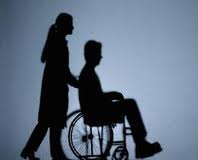PORT-AU-PRINCE, HAITI: When the 2010 earthquake struck, Jean Saint-Phar was buried and knocked unconscious by the collapsing walls of the classroom where he was studying engineering. After he woke up, hours passed with no sign of rescue. He feared he might die like the lifeless student beside him.
“If I would have run from the classroom, I would be dead,” he says. “The school crumpled like a piece of paper. I thought it was the end of the world.”
Jean was trapped for so long that when he was finally rescued, his crushed left foot was infected with gangrene and needed to be amputated. His right foot and ankle were also badly injured and required 18 operations to avoid amputation and regain functionality. Today he wears a prosthetic left foot and walks with only a trace of a limp.
“The most difficult part of my life is taking public transportation,” Jean says. “People can’t see my disability, so I get jostled around in crowds, which makes it difficult to stand and walk sometimes.”
To make matters worse, Jean says, the streets are uneven and the sidewalks are littered with potholes.
“Haiti is a difficult place for people with disabilities,” he says. “My guess is that only three per cent of buildings are truly accessible to people with disabilities.”
A tough situation
Gérald Oriol Jr. knows those challenges all too well. He was born with muscular dystrophy and has been using a wheelchair since the age of 6. He’s also a Harvard graduate and Haiti’s Secretary of State for the Integration of Persons with Disabilities.
“In Haiti, it is estimated that there are about 800,000 to 1,000,000 people with disabilities,” he says. “Unfortunately, we don’t have statistics yet, but these are general estimates.”
“The vast majority of people with disabilities in Haiti live in abject poverty, and the situation, obviously, is very tough. Access to education remains a huge challenge. Access to job training programmes is very difficult.”
That’s the bad news. The good news, Mr. Oriol says, is that the situation is improving, and the Government is working with the support of UNICEF to take a more inclusive and equitable approach to improving the lives of people living with disabilities.
“For instance, right now we’re working with the Ministry of Public Works to ensure that accessibility is considered within the new construction norms,” he says. “We are working with the Ministry of Education to ensure that new schools are accessible to children with disabilities, and we are in the process of rehabilitating several schools as well in different departments to make sure that children with disabilities have access to these schools.”
The Haitian Government has also provided a number of small grants to students like Jean to help them complete their education.
Active citizens
“Children with disabilities – if given the opportunity, if they are able to go to school, if they are able to have access to education, like all children – then they can excel as well. And they can be fully active citizens able to contribute to the country’s development.”
UNICEF shares Mr. Oriol’s vision of protecting the rights of all children, especially the most marginalized.
“While the situation is certainly tough and difficult, the government has pledged to make sure that disability is willing its agenda at the highest level and to improve the general situations of people with disabilities,” he says. “There’s a lot of energy, a lot of attention on the issue of persons with disabilities to make sure that they are not forgotten in the reconstruction of Haiti – that they are fully able to exercise their rights and citizenship, like all persons.”
Learn more about Amid Haiti’s reconstruction here.

